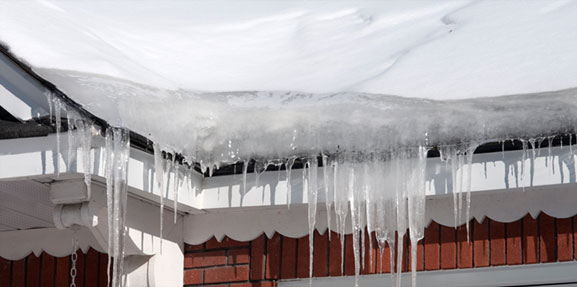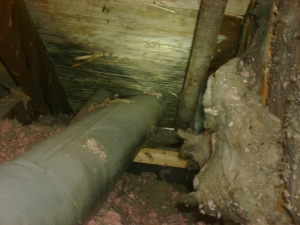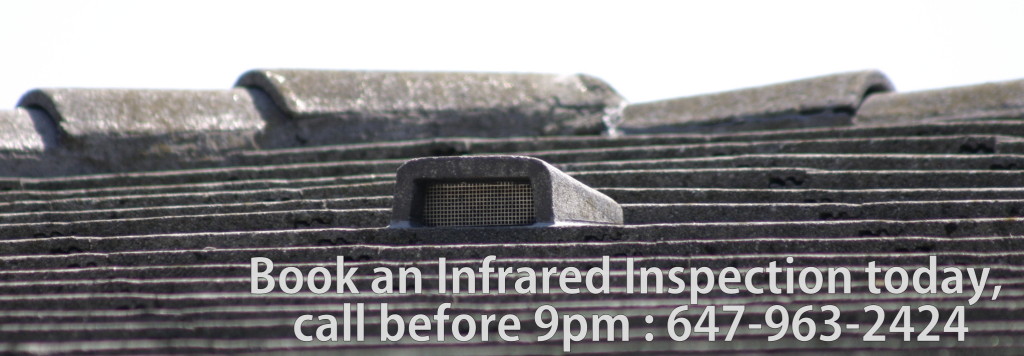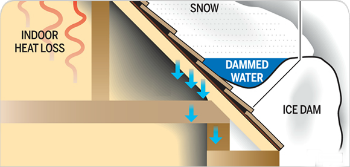Attic
posts displayed by category
What are ice dams and what can home owners do to prevent them.
Oct 24 2013
The bottom portion of the roof forms ice and prevents the ice melts above from draining off the roof. Without ice and water membrane under the roof, water enters the attic and cause all kinds of damage.
Ice damming is a roofing problem unique to northern climates in which the low pitched roofs form ice dams and trap water causing water damage to the roof sheathing and seepage into the building. There are several conditions that has to exist before ice damming occur. Freezing temperatures as already mentioned, a low pitched roof, and a worm attic. When snow falls and accumulates on the roof it may sit there for days. During the day, temperatures may rise above freezing and with the help of the sun, melt the snow which accumulates at the eaves of the roof. At night, temperatures drop below freezing and the melted snow forms an ice dam at the eaves of the roof. As the cycle repeats, the melted snow, now water, enters the roof sheathing. A warm attic accelerates the process.
What can home owners do to prevent ice dams? The atmospheric temperature cannot be controlled but factors around the house can be. Changing the pitch of the roof is not feasible. What is controllable is the insulation and leaks in the attic. Keeping a cold attic is key. Seal the attic leaks and add more insulation to keep the attic cold in the winter are critical steps to preventing ice damming.
Additional measures to help address ice damming include adding eave protection, waterproofing membrane, along the first 18-24 inches of the roof from the eaves. Another anti ice dam measure is the use of heating cables along the eaves. Often, home inspectors view heating cables as an indicator that the house has had ice damming issues in the past. Another indicator of past ice damming issues is pike ax damage marks on the shingles along the eaves. Venting from soffit vents to the roof vents helps keep the attic cold.
The damage ice dams can have on a house can be extensive and mysterious as the water seeps through the roofing shingles and sheathing, and may run along framing members. If undetected, damages can include moisture damage to drywall, ceiling, flooring and creating of an environment friendly to mold.
How improper discharge of vents into attic can cause serious damage to your house.
Oct 23 2013
In winter, when warm air is vented directly into the attic, the moisture in the warm air will condense. Over a season, that can add up to a lot of moisture in your attic and that creates an ideal condition for mold. Furthermore, the roof sheathing start to cup and rot. The moisture can also run down the ceiling and into the drywall, and again, this creates an ideal environment for mold and rot.
So what is mold? Simply put, mold is a fungus found pretty much everywhere on this planet. Ever left food out and after a week or so, the food grows fuzz around it? That’s mold. Aside from food spoilage, molds are microbes involved in all natural material bio-degradation. This also includes building materials such as wood framing members, sheathing, and drywall.
Molds are ubiquitous. Mold spores are a common component of household dust. However, when mold spores are present in large quantities, they can present a health hazard to humans, potentially causing allergic reactions and respiratory problems.
There are thousands of species of molds, all requiring moisture to grow. In the ecosystem, their role is to decompose. The term “toxic mold” refers to molds that produce mycotoxins, such as Stachybotys chartarum.

A kitchen vent discharges directly into the attic, note the black mold on the surrounding roof sheathing, framing and insulation.
Mold around the house is found in damp, dark or steamy areas such as bathroom or kitchen, cluttered storage areas, recently flooded areas, basement areas, plumbing spaces, areas with poor ventilation and outdoors in humid environments. In addition, attics particularly with vents that improperly discharge directly into the attic are prone to supporting mold. Often time when I inspect an attic, it is common see a bathroom vent or kitchen vent discharge directly into the attic, and the framing immediately around the vent discharge is covered in black mold.

A bathroom vent discharging directly into the attic. Depending on the ventilation in the attic, this may not contribute to high humidity levels to support mold. However, this is considered poor building practice, the vent should discharge to the exterior for proper connection.
The key for mold growth around the house, as already mentioned, is a damp environment and a lack of ventilation. For the average home owner, visible mold is relatively easy to spot if you know what you are looking for. However, when mold is hidden behind drywall, a panel, storage items, or behind furniture attached to the wall it may be difficult to identify.
Identifying mold is beyond the scope of a standard home inspection. A good home inspector can recognize conditions the would support mold growth and report that to the client. And, if home buyers expect to buy a home free and clear of any mold, then don’t buy any home because as mentioned above, mold is ubiquitous. They are in your cars, on your clothes, in your hair, on your skin so on. We cannot control their presence, we can only control the environment to limit their growth.

